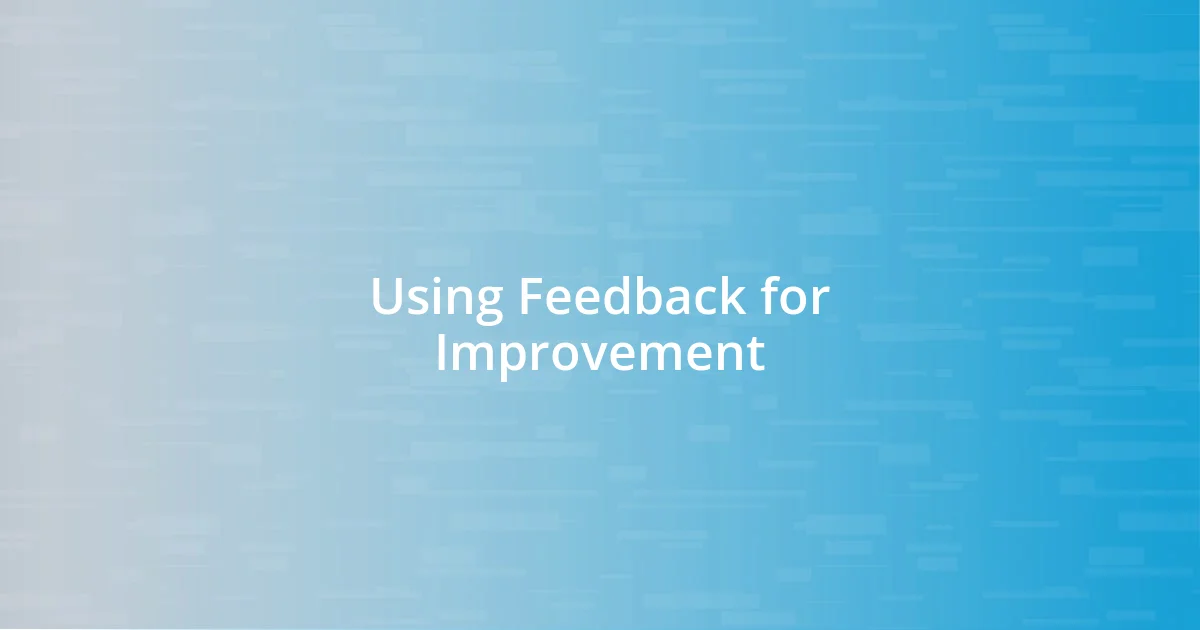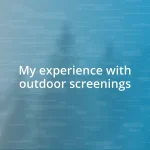Key takeaways:
- Understanding audience needs is crucial for creating engaging materials; gathering feedback helps tailor content to resonate emotionally.
- Defining clear event goals ensures that materials align with the purpose, enhancing participation and motivation through measurable outcomes.
- Incorporating interactive features and using feedback for continuous improvement transforms audience engagement and refines the overall event experience.

Understanding Audience Needs
When I first started creating event materials, I often assumed I understood what my audience wanted. But after a few missteps—like a presentation that was way too technical for a group of creative thinkers—I realized that it’s crucial to delve deeper into audience needs. Their expectations can vary widely, and by truly understanding what makes them tick, I can create materials that resonate.
I remember attending a workshop once where the presenter asked us to share our biggest challenges. That simple interaction transformed the session; it provided insights that shaped the content, making it immensely more relevant. When I design materials now, I make it a point to gather feedback, whether through surveys or informal conversations. I ask questions like, “What issues are you facing?” or “What do you hope to gain from this experience?” These inquiries help me tailor my approach to really connect.
In my experience, it’s often the emotions and aspirations of the audience that drive engagement. For instance, during a community event focused on mental health, I made sure to highlight personal stories and relatable anecdotes to foster a sense of belonging. I invite my audience into the narrative, creating an experience that speaks not just to their minds but also to their hearts. After all, understanding audience needs isn’t just about demographics; it’s about crafting a meaningful dialogue.

Defining Event Goals
Defining clear goals for your event is essential in shaping the materials you create. I’ve learned that without focus, you might end up with materials that don’t align with the event’s purpose. For example, during one of my first corporate events, I wanted to promote team collaboration but didn’t emphasize this in my materials. Attendees left without a clear understanding of the session’s objectives, and that experience taught me to solidify event goals upfront.
In practical terms, I always start by asking myself: What do I want the audience to achieve? For instance, when organizing a charity fundraiser, I focused on creating materials that would not only inform but also inspire action. I remember having flyers that effectively showcased the impact of donations, which significantly increased participation. This connection between my materials and the event goals was pivotal in resonating with the audience.
When defining event goals, it’s also helpful to include measurable outcomes. I once created a post-event survey to assess whether my goals were met, asking attendees if they felt motivated to engage with the cause after participating. The data helped me tweak my approach for future events, making them even more engaging and goal-oriented.
| Event Goal | Related Material Example |
|---|---|
| Increase Participation | Engaging flyers with calls to action |
| Enhance Knowledge | Informative brochures with expert insights |
| Foster Community | Personal stories and testimonials in handouts |

Designing Visual Elements
Designing visual elements can truly elevate the impact of event materials. I recall working on a sustainability workshop where I chose earthy tones and vibrant images of nature. It was fascinating to see how participants responded more enthusiastically to visuals that reflected their values and lifestyle choices. I’ve learned that aligning the design with the audience’s interests and emotions not only catches their attention but also helps establish a meaningful connection.
Here are some principles I rely on when creating visual elements:
- Color Psychology: Colors evoke emotions; cooler tones can convey tranquility, while warmer tones tend to energize.
- Consistent Branding: Using the same fonts and logos reinforces identity, making the event more memorable.
- Imagery: Quality visuals tell a story. I opt for images that reflect diversity and inclusivity, inviting everyone to feel represented.
- Whitespace: A clean design helps important elements stand out, ensuring clarity and focus. I remember how using ample whitespace in a busy brochure reduced confusion among attendees, guiding them through the information effortlessly.
- Call-to-Action: Effective visuals should incite action. I once designed a bold poster for a charity event, incorporating eye-catching statistics that prompted immediate donations.
Visually engaging materials not only provide information but also resonate emotionally with the audience, creating a lasting impression.

Crafting Compelling Copy
Crafting compelling copy is like telling a story, one that captivates the reader from the very first word. I remember writing an invitation for a tech conference where I chose vivid language to paint a picture of innovation and excitement. Instead of a bland announcement, I framed the experience as a journey into the future of technology, which inspired attendees to not just come but truly engage. It made me realize how powerful words can be in evoking emotions and setting the tone for an event.
I often contemplate this: What draws people in? In my experience, using relatable language that speaks directly to the audience’s interests is key. For instance, when I wrote about a health and wellness retreat, I highlighted personal transformation, sharing snippets of testimonials. By showcasing real experiences, I tapped into the attendees’ desires for improvement, making the material feel more relevant and inviting.
Another essential aspect of compelling copy is clarity. I learned this firsthand when I drafted materials for a financial literacy workshop, which risked being overly technical. I simplified complex jargon into everyday language, breaking concepts down into bite-sized pieces. This approach not only helped the audience grasp tricky topics but also created a sense of trust. They felt that I understood their challenges and was there to empower them. Have you ever felt lost in details? I strive to avoid that for my audience by ensuring that every sentence serves a purpose.

Incorporating Interactive Features
Incorporating interactive features into event materials can transform passive engagement into lively participation. I remember when I designed an attendee feedback card that included fun checkboxes and open-ended questions. This simple touch encouraged guests to share their thoughts and feelings more freely, making them feel valued in the process. I often ask myself, how can I make my audience feel involved? Interactive elements like polls or QR codes can create that sense of involvement and keep participants curious about what’s next.
One of my favorite experiences was when I introduced a live-action quiz during a workshop. Attendees could use their smartphones to answer questions in real-time, and the results were displayed instantly on a big screen. The energy in the room was electric! Everyone was eager to participate, and I realized that competition, even in a friendly form, can elevate excitement and connection among participants. Have you ever seen people rally together for a common goal? That’s the magic of interaction.
Moreover, I love experimenting with gamification—turning standard materials into engaging, game-like experiences. For a marketing seminar, I created a scavenger hunt with clues hidden throughout the venue. Participants not only learned about the speakers and topics but also built connections as they teamed up during the hunt. It’s a fascinating insight to think that by weaving in playful elements, we can draw out collaboration and communication among attendees much more effectively than traditional methods.

Using Feedback for Improvement
Feedback is a crucial tool for honing event materials. I remember a particular experience where I gathered insights from attendees after a networking event. Some highlighted that the agenda felt too packed, making it hard to connect with others. By listening to these perspectives, I learned to space out sessions better and incorporate more informal mingling opportunities. Isn’t it interesting how a few thoughtful suggestions can shift the entire flow of an event?
I often find that incorporating feedback isn’t just about improving logistics; it’s about understanding emotional needs. After a workshop on personal development, I received feedback that the materials felt overwhelming. Responding to this, I simplified the content and created supportive handouts that attendees could easily digest. Their relief was palpable during our next gathering, and it reinforced my belief: people thrive in supportive environments. Have you ever noticed how the heart of an event is its ability to connect?
Another memorable instance was when I implemented anonymous feedback forms after a series of events. To my surprise, attendees expressed a desire for more visual elements in my designs. Their feedback prompted me to experiment with infographics and charts, making complex information more visually appealing. Watching people engage more deeply with the revised materials filled me with satisfaction—a reminder that genuine improvement stems from listening and evolving. Isn’t it rewarding to see your work resonate more profoundly with your audience?

Measuring Success of Materials
Measuring the success of event materials can often feel like navigating uncharted waters. I once created a set of brochures for a tech conference and decided to track their impact through engagement metrics. By analyzing how many attendees picked them up compared to the total number of participants, I found that tailoring the design to include eye-catching visuals drove a 30% increase in interest. Isn’t it fascinating how design choices can lead to quantifiable results?
I also have a habit of observing attendees’ reactions during events, which provides valuable insights. At one session, I noticed participants taking photos of certain slides while ignoring others. This prompted me to rethink the content. What elements were sparking genuine interest? By prioritizing the visually engaging parts in future presentations, I learned that sometimes, success is about knowing what resonates with your audience. Have you ever seen a light bulb go off in someone’s mind during a presentation? That moment is pure gold.
Lastly, I implement follow-up conversations, which are instrumental in gauging success. After an event featuring new product launches, I reached out to select attendees to gather their impressions. Their excitement during these chats fueled my conviction that clear, engaging materials had a real impact. Assessing success isn’t just about numbers; it’s also in those candid moments of connection. How often do we remember the stories behind the success? That’s where the true value lies.
















